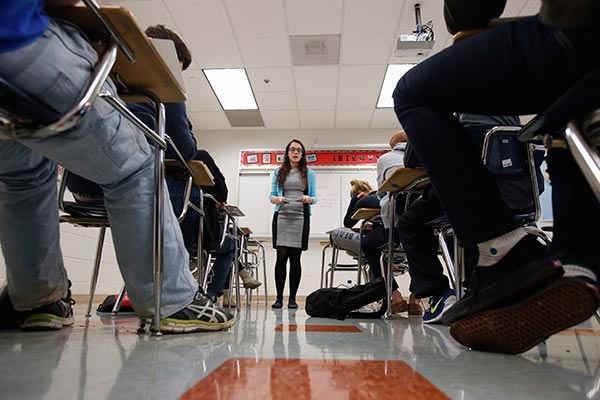The testing struggles of American teens
( Agencies ) Updated: 2016-12-17 10:22:30
 |
|
Katerina Maylock, with Capital Educators, teaches a college test preparation class at Holton Arms School in Bethesda. [Photo provided to China Daily] |
The latest global snapshot of student performance shows declining math scores in the US and stagnant performance in science and reading.
"We're losing ground-a troubling prospect when, in today's knowledge-based economy, the best jobs can go anywhere in the world," says US Education Secretary John B. King Jr. "Students in Massachusetts, Maryland, and Minnesota aren't just vying for great jobs along with their neighbors or across state lines, they must be competitive with peers in Finland, Germany, and Japan."
Math was a stubborn concern. "This pattern that we're seeing in mathematics seems to be consistent with what we've seen in previous assessments ... everything is just going down," says Peggy Carr, acting commissioner at the US National Center for Education Statistics.
The 2015 Program for International Student Assessment, or PISA, study is the latest to document that American students are underperforming their peers in several Asian nations. The US was below the international average in math and about average in science and reading. Singapore was the top performer in all three subjects on the PISA test.
More than half a million 15-year-old students in about 70 nations and educational systems took part in the 2015 exam. The test is coordinated by the Paris-based Organization for Economic Cooperation and Development, or OECD.
Here are the main things to know about the PISA exams:
US scores and rankings
Not so encouraging.
The test is based on a 1,000-point scale. Among the findings:
In math, the US average score was 470, below the international average of 490. Average scores ranged from 564 in Singapore to 328 in the Dominican Republic.
In science, the US average score was 496, about the same as the international average of 493. Average scores ranged from 556 in Singapore to 332 in the Dominican Republic.
In reading, the US average score was 497, around the same as the international average of 493. Average scores ranged from 535 in Singapore to 347 in Lebanon.
Average scores in math have been on the decline since 2009, and scores in reading and science have been flat during that same time period.
Across the globe, American students were outperformed by their counterparts in 36 countries in math; 18 countries in science and 14 countries in reading.
So, what is going on with math?
Andreas Schleicher, director of education and skills at OECD, says high-performing countries do really well in math in three things: rigor, focus, and coherence.
For example, he says, many high-performing countries will teach a lot less but focus at much greater depths, particularly when you look at East Asia, Japan and Singapore.
"Students are often good at answering the first layer of a problem in the United States," says Schleicher. "But as soon as students have to go deeper and answer the more complex part of a problem, they have difficulties."
What people are saying about how the US stacks up
"The latest US PISA achievement results are disappointing but not surprising," said Randi Weingarten, president of the American Federation of Teachers. "They were predictable given the impact of the last 15 years of US education policies combined with continuing state disinvestment following the 2008 recession. Thirty-one states still spend less per pupil than before the recession."
"This stagnant performance on PISA by US students in the last four years once again affirms our belief that the US would be well served to take a hard look at the strategies used by the top-performing education systems and adapt lessons learned from them to fit the US context and needs," says Marc Tucker, president of the National Center on Education and the Economy. "It is critical to look not only at their average high performance, but also at the strategies they use to achieve much greater equity across and within schools compared to the United States."
Other findings
Globally, gender differences in science tended to be smaller than in reading and math. But, on average, in 33 countries and economies, the share of top performers in science is larger among boys than among girls. Finland was the only country where girls were more likely to be top performers than boys.
Across OECD countries, on average, the gender gap in reading in favor of girls narrowed by 12 points between 2009 and 2015.
Massachusetts, North Carolina, and Puerto Rico participated as international benchmarking systems and received separate scores from the United States. Massachusetts's average scores were higher than the US and the international average scores in science, math and reading. North Carolina's average scores were not statistically different from the U.S. average scores for all three subjects. And Puerto Rico's average scores were lower than both the average US scores and the international average scores for all three subjects.
About the test and comparisons
The PISA test is conducted every three years. Schools in each country are randomly selected, and OECD says the selection of schools and students is kept as inclusive as possible so that student samples are drawn from a broad range of backgrounds and abilities.
Another international test, known as the Trends in International Mathematics and Science Study, or TIMSS, had similar international comparisons with Asian countries solidly outperforming American students. That test, though, administered every four years to a random sampling of younger students in dozens of countries, had eighth graders in the US improving their scores in math, up nine points. Scores for science, however, were flat. In fourth grade, scores were unchanged in math and science.
|
|
|
|
|
|
|
|

























 Raymond Zhou:
Raymond Zhou: Pauline D Loh:
Pauline D Loh: Hot Pot
Hot Pot Eco China
Eco China China Dream
China Dream China Face
China Face






